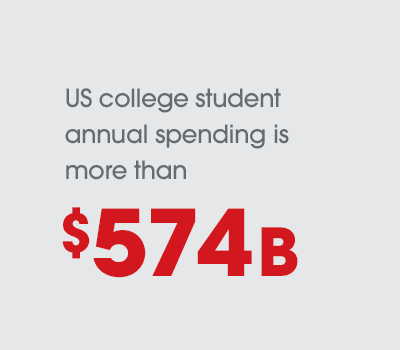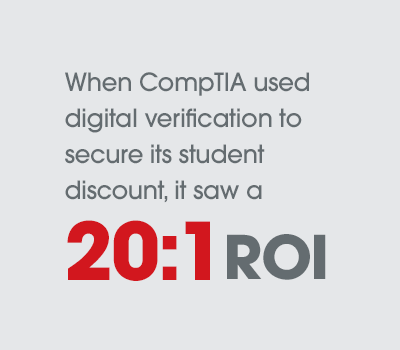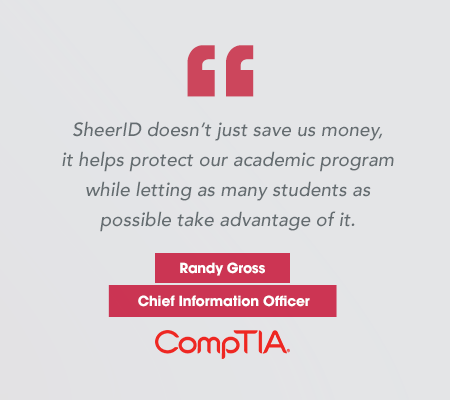Student discount abuse is rampant—as high as 35% with some brands. That can be devastating for brands that use student discounts to attract and nurture new customers.
CompTIA experienced this damage firsthand when it realized fraudsters were ripping off their student discounts and reselling them. To stop the discount abuse, the organization used digital verification—and reaped a 20:1 ROI.
Marketing to students with personalized offers can be an excellent customer acquisition strategy that pays off in long-term loyalty. US college students have more than $574 billion in spending power, and they’re forming brand relationships that will last a lifetime.
CompTIA embraced this approach. The non-profit provides training and other services that prepare the next generation of high-performing IT professionals, and providing student discounts has long been a key element in its marketing strategy. And the hefty 40% student discount is highly appealing.

When a Great Strategy Falls Victim to Fraud
At first, CompTIA implemented the discount by working directly with the students’ schools, who would purchase discount vouchers for their students. But while this worked for some schools, others found the application and voucher process cumbersome. It also limited CompTIA’s reach because only students from partnering schools could participate.
CompTIA decided to expand its program by selling discount vouchers directly to students, who would then verify their eligibility by providing a valid .edu email address. This streamlined the process and enabled CompTIA to reach many more students.
Unfortunately, it also exposed CompTIA to widespread discount abuse.
CompTIA learned that a syndicate was using fake .edu addresses to buy the organization’s student discount vouchers in bulk, and then reselling them to non-verified individuals at a lesser discount. Other fraudsters also leveraged the loopholes of .edu verification and joined in.
This discount abuse not only impacted CompTIA’s revenue, it hurt the organization’s brand reputation and put the entire student program at risk. CompTIA needed a better way to verify students and kick the fraudsters out of the process.
Digital Verification Stops Student Discount Abuse
CompTIA found a solution: digital verification.
With digital verification, CompTIA bypassed .edu verification altogether. Instead of providing an .edu email address, students simply go to CompTIA’s website and enter basic information—such as their name and school—and their eligibility is instantly verified. The process is backed by a document review process, when necessary, to ensure 100% coverage.
Making the switch brought tremendous results. With digital verification, CompTIA reduced student discount abuse by 20% and saw a ROI of 20:1. Randy Gross, CompTIA’s chief information officer, was thrilled.
“We had identified a number of pockets of fraud, and when we implemented SheerID, they quickly disappeared,” Randy said. “SheerID made it impossible to game the system, and it was fun to watch the bad actors wither.”

Digital Verification Delivers Many Rewards
Digital verification doesn’t just secure CompTIA’s student discount. It also helps the organization:
01 Save Time and Resources
Some brands try to avoid the .edu risk by using manual verification, but that’s time-consuming for both customers and employees. Digital verification frees up staff to focus on other priorities. Randy estimated digital verification saves CompTIA more than 12 hours of manual effort each month.
02 Deliver a Better Customer Experience
CompTIA could have used an affiliate to verify eligibility. But that would have meant students had to leave CompTIA’s website and create a separate account with a third-party vendor. With digital verification, students remain on CompTIA’s website, and the process is fast, easy, and entirely in-brand.
03 Collect Valuable Customer Data
The goal of a student discount is to win long-term loyalty. Affiliates that provide verification keep the customer data they collect and use it to market on behalf of all their clients. With digital verification, CompTIA collects the data directly and can use it to engage students with products and services throughout their IT careers.
04 Market to Students Worldwide
CompTIA currently offers certifications in 38 countries on five continents. Digital verification can verify students in 191 countries, giving CompTIA the potential to securely reach their entire global audience, even in geographic areas that are highly prone to fraud.
“SheerID makes it much easier to expand into international markets,” Randy said. “It doesn’t just save us money, it helps protect our academic program while letting as many students as possible take advantage of it.”








